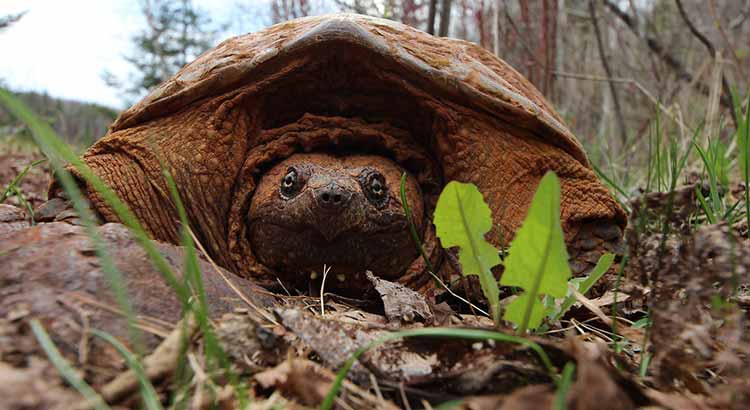Turtles are able to do a lot of amazing things, and one of them is breathing through their butts. But if they are able to do this, a new question arises, how do they poop? Do they breathe and poop from the same place?
How do turtles poop? Turtles poop through their cloaca, which is an opening that can be found at the base of their tail.
So turtles poop and breath through their cloaca, but what is this cloaca that is able to do so many things?
Cloaca
A cloaca is a small orifice that can usually be found at the back end of an animal, and it has many different roles depending on the species of the animal.
You might have heard at some point something like: turtles are able to breathe through their butts. And as weird as it sounds that is kind of true, the cloaca is positioned at the end of the turtle’s body so it can be considered the butt of the turtle. But the cloaca acts differently than how you would normally expect a “back end” to work, let’s take for example another animal that we all know, the dog. The purpose of a dog’s anus is to execrate, and that is it, it’s not involved in any other biological processes. But the cloaca is used for more than that.
The cloaca has 4 important roles: execration, urination, reproduction, and breathing. Turtles use only one orifice for those things and that is the cloaca.
The cloaca can be found in other animals as well, they are not exclusive to turtles. Most birds have a cloaca, some fishes, and a few mammals. The cloaca can be a little different for other animals, but those that have it will generally use it for the same purpose, with the exception of breathing, not too many animals that have a cloaca use it for breathing, mainly because they don’t have any reason to do it.
For turtles, the cloaca consists of the Urodeum, the central part of the cloaca that receives urine from the ureter, Proctodeum, the back ectodermal part of an alimentary canal, and the Coprodeum.
Cloacas are also used to lay eggs, when turtles lay their eggs, they expel them through the cloaca.
Here is a video of a turtle laying eggs through its cloaca, in the video you can see clearly that the eggs leave the turtle’s body at the base of the tail.
https://www.youtube.com/watch?v=XyiwCNDsdyM
If you own an aquatic turtle and you want to see your turtle using its cloaca to breathe, you can easily do so. Just look at the back end of the turtle when it’s swimming around, if you spend 15 minutes looking you have pretty big chances of seeing it in action.
If you want to see a cloaca, but you don’t own a turtle, here are a couple of links that will show you a cloaca up close. I chose not to post them as pictures because they can be a little gross, but if that is not a problem for you, here are the links:
Conclusion
So turtles poop through the same place that they breathe through, and that is the cloaca. But the cloaca does not limit itself to this. The cloaca is also used when laying eggs, and when urinating.
I hope this answered all your questions about how turtles poop. But in case you have any questions left, you can always leave them in the comment section and I will answer them as soon as possible.



I have a baby turtle and I think it is a map turtle. I am wondering why it flips itself on its back? Usually he does so when he is basking under his heat lamp. It is the weirdest thing
Turtles flipping themselves onto their backs can be a concern because they have difficulty righting themselves. If your baby turtle frequently flips onto its back, it may be a sign of an issue with its basking area or habitat. Here are some possible reasons and solutions:
Inadequate Basking Area: If the basking area is too small, smooth, or lacks proper traction, the turtle may struggle to maintain its balance. Ensure the basking area is spacious, has a non-slip surface, and is easy for the turtle to climb onto.
Inadequate Heat and Light: Turtles require the right temperature and UVB lighting to thermoregulate and metabolize calcium properly. If the basking area isn’t warm enough or doesn’t have appropriate UVB lighting, the turtle might become less active and flip over more frequently. Ensure that the basking area is heated to the correct temperature and has a UVB lamp providing the necessary UVB radiation.
Stress or Discomfort: If the turtle feels stressed or uncomfortable in its enclosure, it might exhibit unusual behaviors. Make sure the enclosure is appropriately set up with clean water, hiding spots, and a comfortable basking area.
Examination: Observe your turtle for any signs of illness or injury. Turtles may flip over if they have shell or limb problems that affect their ability to right themselves.
Inadequate Water Depth: Young turtles need an appropriate water depth in their enclosure. If the water is too shallow, they may flip over while swimming. Ensure the water depth is suitable for their size and species.
Overcrowding: If the enclosure is overcrowded with decorations or other turtles, your turtle might feel stressed or uncomfortable, leading to odd behavior. Make sure the enclosure provides adequate space and an uncluttered basking area.
If your baby turtle continues to flip over despite addressing these issues, it’s essential to consult a reptile veterinarian. They can perform a thorough examination to rule out any underlying health problems or abnormalities. Keep a close eye on your turtle’s behavior, and don’t hesitate to seek professional advice if you have concerns about its well-being.